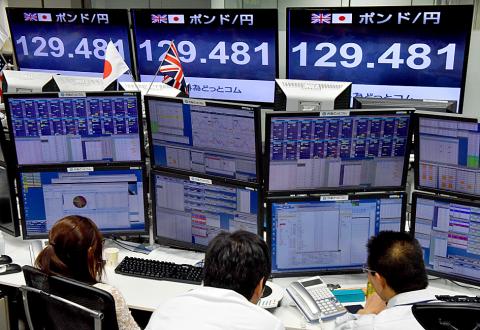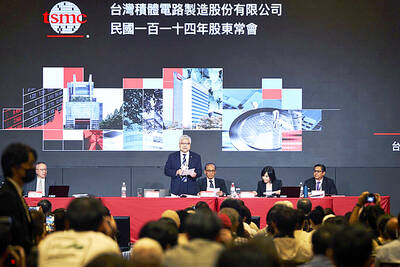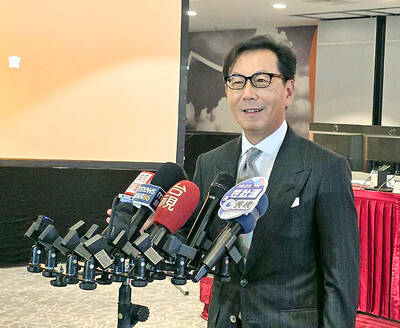Sterling yesterday suffered a dizzying “flash crash” against the euro and dollar in a computer-generated sell-off, sending Brexit shockwaves across markets after France warned of perils ahead for Britain.
The pound plunged more than 6 percent against the US dollar in under 10 minutes in Asian trading hours — at the end of a tumultuous week of heavy losses after British Prime Minister Theresa May signalled she would trigger Britain’s departure from the EU by the end of March next year.
A Bank of England spokesman said that it was “looking into” the cause of the flash crash — a vertiginous drop in an asset’s value that can be triggered and exacerbated by automated trading systems.

Photo: AFP
French President Francois Hollande on Thursday said the EU should take a tough line with London during exit talks to prevent the break-up of the bloc.
“There must be a threat, there must be a risk, there must be a price, otherwise we will be in negotiations that will not end well and, inevitably, will have economic and human consequences,” he said.
“Britain has decided on a Brexit, I believe even a hard Brexit. Well, we must go all the way with Britain’s willingness to leave the European Union,” Holland said. “We must have this firmness.”
“The value of sterling plummeted overnight as algorithmic trading programs apparently triggered a crash,” XTB analyst David Cheetham said.
“Comments from French President Hollande [surfaced] a minute before the selling began, so it seems far more plausible that news-scanning algorithmic trading systems began a move which gathered momentum,” he said.
Cheetham added that a combination of trades placed by algorithms and stop-loss orders can “exacerbate the move, which is commonly seen to retrace by a significant proportion of the decline within a matter of minutes.”
Stop-loss orders are automatic orders to buy or sell an asset once it reaches a certain price level.
The pound fell off a cliff at about 2310 GMT on Thursday to strike a 31-year low at US$1.1841, before rebounding back above US$1.24.
“A lot of investors are still scratching their heads as to how and why it happened, whether it was a fat fingered trader in Tokyo, an algorithm scanning for any negative Brexit news, or just a big seller of the pound,” said analyst Alex Edwards at trading firm UKForex. “Whatever it was, it shows us that the pound is looking very vulnerable right now.”
Approaching midday in London, the pound rowed back to US$1.2368, while the euro stood at 89.99 pence.
Yesterday’s crash was the pound’s second-largest intra-day decline, bettered only by its precipitous 11-percent slump on June 24, when the shock Brexit result emerged.
Yosuke Hosokawa, head of FX sales team at Sumitomo Mitsui Trust Bank, said: “We thought today’s plunge was a matter of time.”
“Negative factors were mounting against the pound, and eventually the dam broke. We have not seen the bottom yet. Breaking the 31-year low is now in sight,” Hosokawa said.
The fright in foreign exchanges was reflected on Asia’s stock markets as investors fled high-risk assets, with losses across the board.
Tokyo ended down 0.2 percent and Hong Kong slipped 0.5 percent in the afternoon, while Sydney closed 0.3 percent lower and Seoul eased 0.6 percent.
The London stock market yesterday advanced as the weak pound boosted exporters.

CAUTIOUS RECOVERY: While the manufacturing sector returned to growth amid the US-China trade truce, firms remain wary as uncertainty clouds the outlook, the CIER said The local manufacturing sector returned to expansion last month, as the official purchasing managers’ index (PMI) rose 2.1 points to 51.0, driven by a temporary easing in US-China trade tensions, the Chung-Hua Institution for Economic Research (CIER, 中華經濟研究院) said yesterday. The PMI gauges the health of the manufacturing industry, with readings above 50 indicating expansion and those below 50 signaling contraction. “Firms are not as pessimistic as they were in April, but they remain far from optimistic,” CIER president Lien Hsien-ming (連賢明) said at a news conference. The full impact of US tariff decisions is unlikely to become clear until later this month

GROWING CONCERN: Some senior Trump administration officials opposed the UAE expansion over fears that another TSMC project could jeopardize its US investment Taiwan Semiconductor Manufacturing Co (TSMC, 台積電) is evaluating building an advanced production facility in the United Arab Emirates (UAE) and has discussed the possibility with officials in US President Donald Trump’s administration, people familiar with the matter said, in a potentially major bet on the Middle East that would only come to fruition with Washington’s approval. The company has had multiple meetings in the past few months with US Special Envoy to the Middle East Steve Witkoff and officials from MGX, an influential investment vehicle overseen by the UAE president’s brother, the people said. The conversations are a continuation of talks that

CHIP DUTIES: TSMC said it voiced its concerns to Washington about tariffs, telling the US commerce department that it wants ‘fair treatment’ to protect its competitiveness Taiwan Semiconductor Manufacturing Co (TSMC, 台積電) yesterday reiterated robust business prospects for this year as strong artificial intelligence (AI) chip demand from Nvidia Corp and other customers would absorb the impacts of US tariffs. “The impact of tariffs would be indirect, as the custom tax is the importers’ responsibility, not the exporters,” TSMC chairman and chief executive officer C.C. Wei (魏哲家) said at the chipmaker’s annual shareholders’ meeting in Hsinchu City. TSMC’s business could be affected if people become reluctant to buy electronics due to inflated prices, Wei said. In addition, the chipmaker has voiced its concern to the US Department of Commerce

STILL LOADED: Last year’s richest person, Quanta Computer Inc chairman Barry Lam, dropped to second place despite an 8 percent increase in his wealth to US$12.6 billion Staff writer, with CNA Daniel Tsai (蔡明忠) and Richard Tsai (蔡明興), the brothers who run Fubon Group (富邦集團), topped the Forbes list of Taiwan’s 50 richest people this year, released on Wednesday in New York. The magazine said that a stronger New Taiwan dollar pushed the combined wealth of Taiwan’s 50 richest people up 13 percent, from US$174 billion to US$197 billion, with 36 of the people on the list seeing their wealth increase. That came as Taiwan’s economy grew 4.6 percent last year, its fastest pace in three years, driven by the strong performance of the semiconductor industry, the magazine said. The Tsai